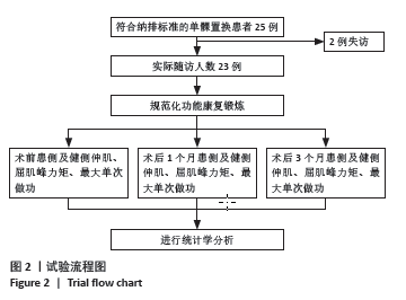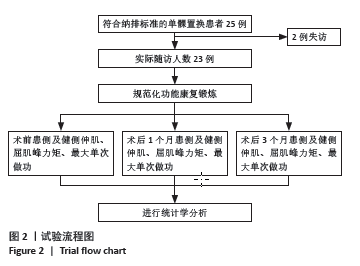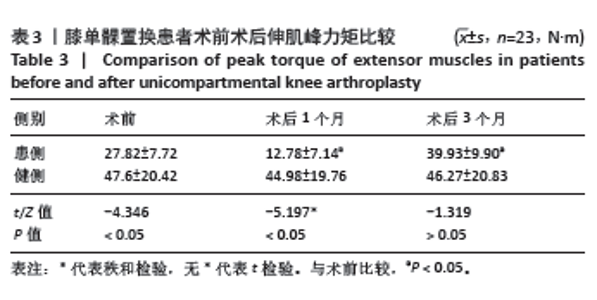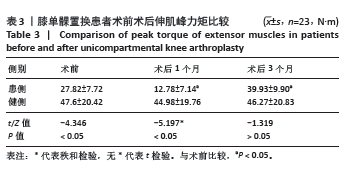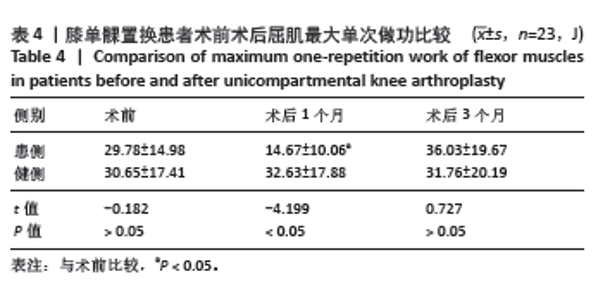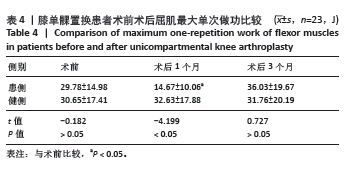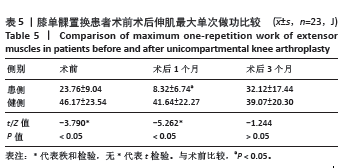Chinese Journal of Tissue Engineering Research ›› 2025, Vol. 29 ›› Issue (27): 5833-5838.doi: 10.12307/2025.180
Previous Articles Next Articles
Characteristic analysis of isometric muscle strength of knee joint in patients after unicompartmental knee arthroplasty
Ding Yuan1, Gong Jianbao1, Zhang Jie2, Qiao Yuan1, Xu Wenlong1
- 1Qingdao Municipal Hospital, Qingdao 266000, Shandong Province, China; 2Qingdao Medical College of Qingdao University, Qingdao 266000, Shandong Province, China
-
Received:2024-03-09Accepted:2024-04-29Online:2025-09-28Published:2025-03-05 -
Contact:Xu Wenlong, MS, Attending physician, Qingdao Municipal Hospital, Qingdao 266000, Shandong Province, China -
About author:Ding Yuan, PhD, Attending physician, Qingdao Municipal Hospital, Qingdao 266000, Shandong Province, China
CLC Number:
Cite this article
Ding Yuan, Gong Jianbao, Zhang Jie, Qiao Yuan, Xu Wenlong. Characteristic analysis of isometric muscle strength of knee joint in patients after unicompartmental knee arthroplasty[J]. Chinese Journal of Tissue Engineering Research, 2025, 29(27): 5833-5838.
share this article
Add to citation manager EndNote|Reference Manager|ProCite|BibTeX|RefWorks

2.3 基础信息 纳入的25例患者中,23例完成了随访测试,其余2例患者未完成随访测试,失访率约为8%。在完成随访的23例患者中,男10例(44%),女13例(56%)。入院患者年龄53-79岁,平均(66.65±7.73)岁。8例进行左膝单髁置换术(35%),15例进行右膝单髁置换术(65%)。 2.4 屈肌峰力矩 与健侧对比,术前屈肌峰力矩患侧低于健侧,但无显著性差异(P > 0.05);术后1个月显著低于健侧(P < 0.05);术后3个月患侧高于健侧,但无显著性差异(P > 0.05);术前术后对比,患侧术后1个月显著低于术前(P < 0.05),术后3个月显著高于术前(P < 0.05),详见表2。"
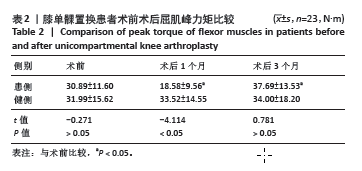
| [1] 陈瑞楠,陈国茜,刘迅,等. 软骨和软骨下骨与膝骨关节炎关系的研究进展[J]. 中医正骨,2023,35(3):55-60. [2] SILVERWOOD V, BLAGOJEVIC-BUCKNALL M, JINKS C, et al. Current evidence on risk factors for knee osteoarthritis in older adults: a systematic review and meta-analysis. Osteoarthritis Cartilage. 2015; 23(4):507-515. [3] DENG M, HU Y, ZHANG Z, et al. Unicondylar knee replacement versus total knee replacement for the treatment of medial knee osteoarthritis: a systematic review and meta-analysis. Arch Orthop Trauma Surg. 2021;141(8):1361-1372. [4] 彭洪俊,曾羿. 肌肉减少症和骨关节炎相关性研究进展[J]. 中国修复重建外科杂志,2022,36(12):1549-1557. [5] LESPASIO MJ, PIUZZI NS, HUSNI ME, et al. Knee Osteoarthritis: A Primer. Perm J. 2017;21:16-183. [6] KOLASINSKI SL, NEOGI T, HOCHBERG MC, et al. 2019 American College of Rheumatology/Arthritis Foundation Guideline for the Management of Osteoarthritis of the Hand, Hip, and Knee. Arthritis Care Res (Hoboken). 2020;72(2):149-162. [7] GRESS K, CHARIPOVA K, AN D, et al. Treatment recommendations for chronic knee osteoarthritis. Best Pract Res Clin Anaesthesiol. 2020; 34(3):369-382. [8] ARDEN NK, PERRY TA, BANNURU RR, et al. Non-surgical management of knee osteoarthritis: comparison of ESCEO and OARSI 2019 guidelines. Nat Rev Rheumatol. 2021;17(1):59-66. [9] 凌晶,涂以济,王识程,等.单髁置换术治疗高龄膝关节骨关节炎疗效的倾向评分匹配研究[J]. 中国骨伤,2023,36(2):151-156. [10] TIAN S, LIU J, YUAN W, et al. Minimally invasive unicompartmental knee replacement: Midterm clinical outcome. PLoS One. 2017;12(5): e176082. [11] 陈诊,徐良志,黄志龙,等. 单髁置换术与全膝关节置换术治疗老年膝骨关节炎患者的效果比较[J]. 中国民康医学,2023,35(22): 143-145. [12] RADIN EL, YANG KH, RIEGGER C, et al. Relationship between lower limb dynamics and knee joint pain. J Orthop Res. 1991;9(3):398-405. [13] LIIKAVAINIO T, ISOLEHTO J, HELMINEN HJ, et al. Loading and gait symmetry during level and stair walking in asymptomatic subjects with knee osteoarthritis: importance of quadriceps femoris in reducing impact force during heel strike? Knee. 2007;14(3):231-238. [14] O’HARA BP, URBAN JP, MAROUDAS A. Influence of cyclic loading on the nutrition of articular cartilage. Ann Rheum Dis. 1990;49(7):536-539. [15] BASDELIOGLU K, MERIC G, PUNDUK Z, et al. Outcomes of isokinetic tests and functional assessment of anterior cruciate ligament reconstruction: Transtibial versus single anatomic femoral tunnel technique. Acta Orthop Traumatol Turc. 2019;53(2):86-91. [16] 陈鉴冰,叶倩云,朱晓峰. 膝骨关节炎致病危险因素的meta分析[J]. 暨南大学学报(自然科学与医学版),2023,44(4):406-415. [17] LAWRENCE RC, FELSON DT, HELMICK CG, et al. Estimates of the prevalence of arthritis and other rheumatic conditions in the United States. Part II. Arthritis Rheum. 2008;58(1):26-35. [18] ATAR S, DEMIRHAN E, CABUK H, et al. Comparison of Pain, Muscle Strength, and Functional Status Following Unicompartmental Knee Arthroplasty, Total Knee Arthroplasty, and Conservative Management of Gonarthrosis. Indian J Orthop. 2022;56(3):464-472. [19] BARBOUR KE, HELMICK CG, BORING M, et al. Vital Signs: Prevalence of Doctor-Diagnosed Arthritis and Arthritis-Attributable Activity Limitation - United States, 2013-2015. MMWR Morb Mortal Wkly Rep. 2017;66(9):246-253. [20] KATZ JN, ARANT KR, LOESER RF. Diagnosis and Treatment of Hip and Knee Osteoarthritis: A Review. JAMA. 2021;325(6):568-578. [21] VINCENT KR, VINCENT HK. Resistance exercise for knee osteoarthritis. PM R. 2012;4(5 Suppl):S45-S52. [22] BYRNE C, FAURE C, KEENE DJ, et al. Ageing, Muscle Power and Physical Function: A Systematic Review and Implications for Pragmatic Training Interventions. Sports Med. 2016;46(9):1311-1332. [23] DE ZWART A, DEKKER J, VERBERNE S, et al. Association Between Measures of Muscle Strength and Performance of Daily Activities in Patients with Knee Osteoarthritis. J Rehabil Med. 2022;54:jrm00316. [24] SINGLA R, NIEDERER D, FRANZ A, et al. The course of knee extensor strength after total knee arthroplasty: a systematic review with meta-analysis and -regression. Arch Orthop Trauma Surg. 2023;143(8): 5303-5322. [25] 张延杰,黄霄汉,李继超. 股四头肌等长收缩训练治疗髌骨软化症临床观察[J]. 光明中医, 2020,35(9):1336-1338. [26] 孙文娟,任玉香,杨鑫,等. 膝关节手术术后关节源性肌肉抑制的原理及治疗[J]. 罕少疾病杂志, 2022,29(1):109-112. [27] JAKOBSEN TL, KEHLET H, HUSTED H, et al. Early progressive strength training to enhance recovery after fast-track total knee arthroplasty: a randomized controlled trial. Arthritis Care Res (Hoboken). 2014;66(12): 1856-1866. [28] HURLEY MV, JONES DW, NEWHAM DJ. Arthrogenic quadriceps inhibition and rehabilitation of patients with extensive traumatic knee injuries. Clin Sci (Lond). 1994;86(3):305-310. [29] 李之琛,陈东峰,赵杰,等. 单髁与全膝关节置换术对伸膝肌力影响的差异[J]. 中华关节外科杂志(电子版),2017,11(3):246-249. [30] KUROWICKI J, KHLOPAS A, SULTAN AA, et al. Improvement in hamstring and quadriceps muscle strength following cruciate-retaining single radius total knee arthroplasty. Ann Transl Med. 2017;5(Suppl 3):S27. [31] MIZNER RL, PETTERSON SC, SNYDER-MACKLER L. Quadriceps strength and the time course of functional recovery after total knee arthroplasty. J Orthop Sports Phys Ther. 2005;35(7):424-436. [32] MEIER W, MIZNER RL, MARCUS RL, et al. Total knee arthroplasty: muscle impairments, functional limitations, and recommended rehabilitation approaches. J Orthop Sports Phys Ther. 2008;38(5): 246-256. [33] THOMAS AC, STEVENS-LAPSLEY JE. Importance of attenuating quadriceps activation deficits after total knee arthroplasty. Exerc Sport Sci Rev. 2012;40(2):95-101. [34] STEVENS JE, MIZNER RL, SNYDER-MACKLER L. Quadriceps strength and volitional activation before and after total knee arthroplasty for osteoarthritis. J Orthop Res. 2003;21(5):775-779. [35] POZZI F, SNYDER-MACKLER L, ZENI J. Physical exercise after knee arthroplasty: a systematic review of controlled trials. Eur J Phys Rehabil Med. 2013;49(6):877-892. [36] WANG XF, MA ZH, TENG XR. Isokinetic Strength Test of Muscle Strength and Motor Function in Total Knee Arthroplasty. Orthop Surg. 2020;12(3):878-889. |
| [1] | Liu Wenlong, Dong Lei, Xiao Zhengzheng, Nie Yu. Finite element analysis of tibial prosthesis loosening after fixed-bearing unicompartmental knee arthroplasty for osteoporosis [J]. Chinese Journal of Tissue Engineering Research, 2026, 30(9): 2191-2198. |
| [2] | Li Linzhen, Jiao Hongzhuo, Chen Weinan, Zhang Mingzhe, Wang Jianlong, Zhang Juntao. Effect of icariin-containing serum on lipopolysaccharide-induced inflammatory damage in human chondrocytes [J]. Chinese Journal of Tissue Engineering Research, 2026, 30(6): 1368-1374. |
| [3] | Zhou Jian, Zhang Tao, Zhou Weili, Zhao Xingcheng, Wang Jun, Shen Jie, Qian Li, Lu Ming. Effects of resistance training on quadriceps mass and knee joint function in patients with osteoporosis and sarcopenia [J]. Chinese Journal of Tissue Engineering Research, 2026, 30(5): 1081-1088. |
| [4] | Li Hanyue, Li Yini, Xiang Linmei, Li Sen. Effects of resistance exercise therapy on pain and function in patients with cervical spondylotic radiculopathy: a meta-analysis [J]. Chinese Journal of Tissue Engineering Research, 2026, 30(4): 987-996. |
| [5] | Sun Jiahe, Shi Jipeng, Zhu Tianrui, Quan Helong, Xu Hongqi. Effect of exercise intervention in elderly individuals with sarcopenia and its comorbidities: a meta-analysis [J]. Chinese Journal of Tissue Engineering Research, 2026, 30(4): 997-1007. |
| [6] | Gu Fucheng, Yang Meixin, Wu Weixin, Cai Weijun, Qin Yangyi, Sun Mingyi, Sun Jian, Geng Qiudong, Li Nan. Effects of Guilu Erxian Glue on gut microbiota in rats with knee osteoarthritis: machine learning and 16S rDNA analysis [J]. Chinese Journal of Tissue Engineering Research, 2026, 30(4): 1058-1072. |
| [7] | Zhang Anqi, Hua Haotian, Cai Tianyuan, Wang Zicheng, Meng Zhuo, Zhan Xiaoqian, Chen Guoqian . Pain after total knee arthroplasty: current status and trend analysis [J]. Chinese Journal of Tissue Engineering Research, 2026, 30(3): 795-804. |
| [8] | Li Xiaomin, Tian Xiangdong, Wang Chaolu. High tibial osteotomy on a single plane: femorofibular angle as a reference marker for mechanical axis correction [J]. Chinese Journal of Tissue Engineering Research, 2026, 30(3): 570-576. |
| [9] | Guo Jingwen, Wang Qingwei, He Zijun, Hu Zihang, Chen Zhi, Zhu Rong, Wang Yuming, Liu Wenfei, Luo Qinglu. Intra-articular injection of different concentrations of silicon-based bioceramics in treatment of knee osteoarthritis in rats [J]. Chinese Journal of Tissue Engineering Research, 2026, 30(2): 288-295. |
| [10] | Li Tingwen, , Zhang Jianhua. Meta-analysis of the effects of aquatic exercise on balance function and motor ability in elderly patients with Parkinson’s disease [J]. Chinese Journal of Tissue Engineering Research, 2026, 30(10): 2560-2568. |
| [11] | Zhou Jinhai, Li Jiangwei, Wang Xuquan, Zhuang Ying, Zhao Ying, Yang Yuyong, Wang Jiajia, Yang Yang, Zhou Shilian. Three-dimensional finite element analysis of anterior femoral notching during total knee arthroplasty at different bone strengths [J]. Chinese Journal of Tissue Engineering Research, 2025, 29(9): 1775-1782. |
| [12] | Ma Chi, Wang Ning, Chen Yong, Wei Zhihan, Liu Fengji, Piao Chengzhe. Application of 3D-printing patient-specific instruments combined with customized locking plate in opening wedge high tibial osteotomy [J]. Chinese Journal of Tissue Engineering Research, 2025, 29(9): 1863-1869. |
| [13] | Sun Yundi, Cheng Lulu, Wan Haili, Chang Ying, Xiong Wenjuan, Xia Yuan. Effect of neuromuscular exercise for knee osteoarthritis pain and function: a meta-analysis [J]. Chinese Journal of Tissue Engineering Research, 2025, 29(9): 1945-1952. |
| [14] | Zhang Zixian, Xu Youliang, Wu Shaokui, Wang Xiangying. Effects of blood flow restriction training combined with resistance training on muscle indicators in college athletes: a meta-analysis [J]. Chinese Journal of Tissue Engineering Research, 2025, 29(8): 1705-1713. |
| [15] | Wang Juan, Wang Guanglan, Zuo Huiwu. Efficacy of exercise therapy in the treatment of anterior cruciate ligament reconstruction patients: #br# a network meta-analysis #br# [J]. Chinese Journal of Tissue Engineering Research, 2025, 29(8): 1714-1726. |
| Viewed | ||||||
|
Full text |
|
|||||
|
Abstract |
|
|||||
